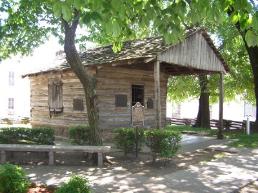 |
| Brig. Gen. Albert Pike, C.S.A. Library of Congress |
Perhaps the most enigmatic of all Confederate generals, Brigadier General Albert Pike was the commander of Southern forces in the Indian Nations of what is now Oklahoma when the Pea Ridge Campaign developed in 1862.
Born in Boston on December 29, 1809, Pike was the son of a cobbler and one of six children in a hard-working Massachusetts family. He attended public school where, in the tradition of that day, he received an excellent education that included studies in Hebrew, Latin and Greek as well as literature and mathematics. At the age of only 16 he passed the entrance exam for Harvard, but could not afford to go due to the cost of the tuition.
Instead of going on to college, Albert Pike becake a teacher and a poet. He published his first poem at the age of 23 and his work appeared in some of the leading literary journals of his day.
 |
| Albert Pike School in Van Buren, Arkansas |
 |
| Pike fought a Duel on the River in Fort Smith |
 |
| Brig. Gen. Albert Pike, C.S.A. National Park Service |
It was as a brigadier general in command of the troops from the Indian Nations that Pike would take part in the Battle of Pea Ridge, the largest action in which he would fight. In a dispute with General Thomas C. Hindman over which man commanded the forces and supplies in the Indian Territory, Pike resigned his post on July 12, 1862, just four months after the Battle of Pea Ridge.
Albert Pike is perhaps best known, however for his involvement with the Masonic Lodge. He became a Mason in 1850 and in 1859 became Grand Commander of the Supreme Council, Southern Jurisdiction, which made him the leader of all of the South's Masons. In 1871 he published Morals and Dogma for the Scottish Rite and later penned several other books on Masonry. Appropriately he died at the Scottish Rite Temple in Washington, D.C. on April 2, 1891 and is now buried in a crypt inside the temple.
General Albert Pike would play a signficant and controversial role in the Battle of Pea Ridge and his involvement in the campaign will be dealt with extensively over coming days and weeks. You can learn about his little one-room school in Van Buren by visiting www.exploresouthernhistory.com/pikeschoolhouse.
No comments:
Post a Comment